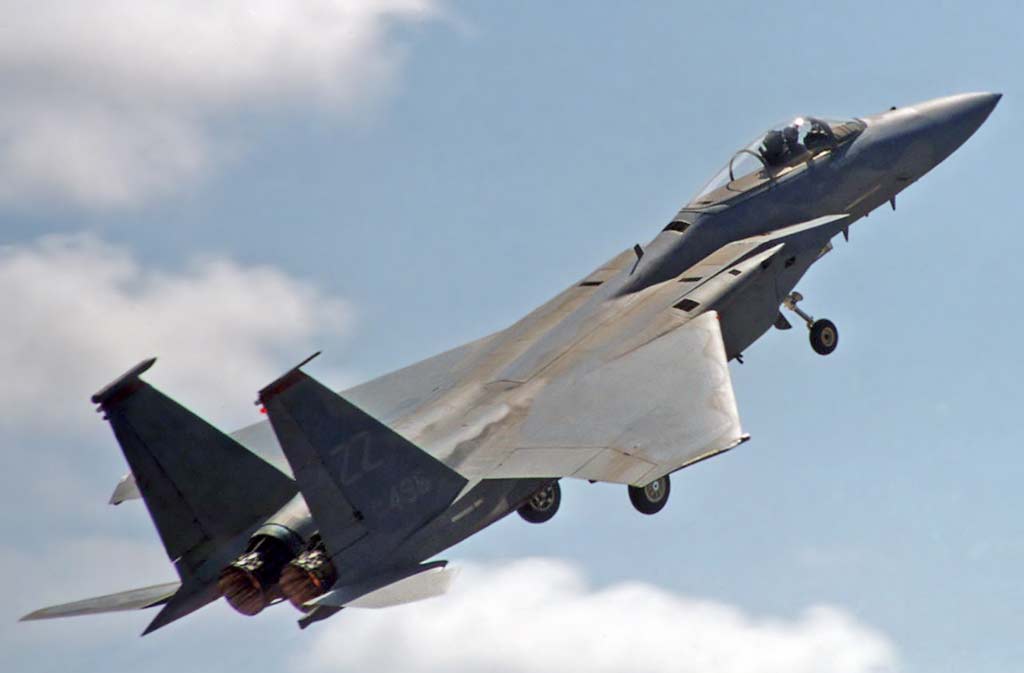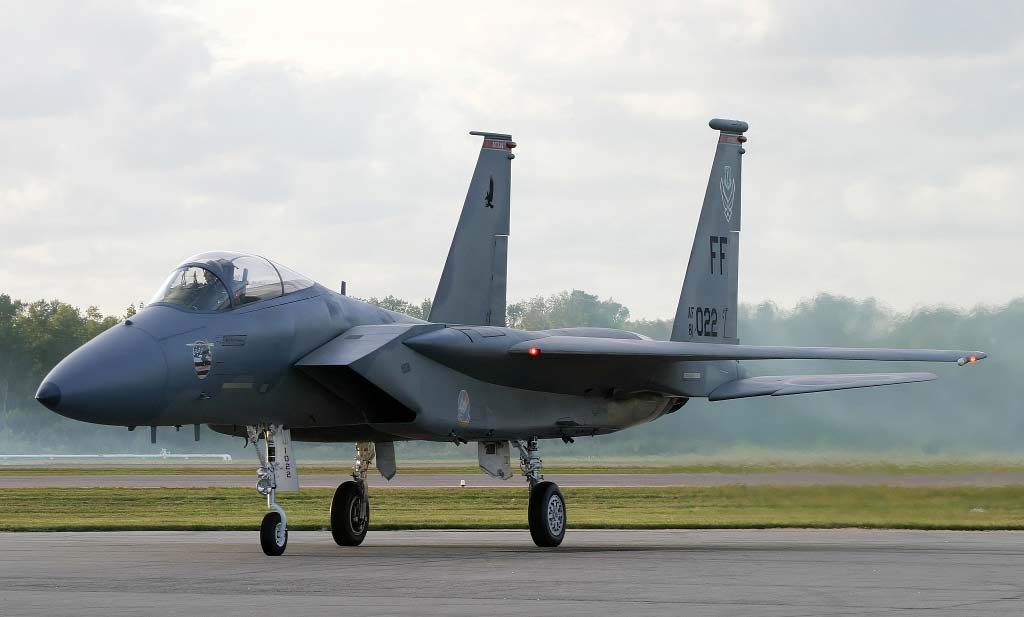F-15 Eagle: US tactical fighter with unmatched air superiority capabilities.
In brief
The Boeing F-15 Eagle is a highly maneuverable, tactical fighter designed to gain and maintain air superiority in aerial combat. It is known for its incredible acceleration and agility, powered by two Pratt & Whitney F100-PW-100 or -220 engines, producing up to 23,830 pounds of thrust each with afterburners. The F-15 has a top speed of Mach 2.5+ and an operational ceiling above 65,000 feet. Its design includes a mix of advanced aerodynamics, avionics, and weapons systems, enabling it to carry a wide range of armaments including AIM-7 Sparrow missiles, AIM-9 Sidewinder, and various air-to-ground ordnance. Introduced in the 1970s, the Eagle has been a pivotal air combat platform with a record of over 100 aerial combat victories without losses.

History of the Development of the Boeing (McDonnell Douglas) F-15 Eagle
In the late 1960s, the United States Air Force (USAF) recognized the need for a dedicated air superiority fighter to counter the rapidly advancing Soviet aircraft technologies of the era. The Vietnam War had exposed several deficiencies in existing American fighter aircraft, primarily in agility and air-to-air combat capabilities against smaller, more nimble opponents like the MiG-21. This led to the initiation of the FX program (Fighter Experimental), aimed at developing a next-generation fighter that emphasized maneuverability, acceleration, and load-carrying capacity.
McDonnell Douglas, which later merged with Boeing, was awarded the contract to develop this new fighter jet, which would eventually become the F-15 Eagle. The development program was officially launched in 1969, with the key objective of producing a fighter that could engage and defeat any enemy aircraft with unparalleled air-to-air capabilities. The F-15 first flew on July 27, 1972, quickly demonstrating performance that exceeded initial expectations.
The F-15 was designed during a period of intense Cold War competition, where technological superiority in the skies was seen as crucial to national security. The aircraft was equipped from the outset with advanced radar and avionics to detect and engage hostile aircraft at long distances, a response to the threats posed by advanced Soviet fighters of the time.
Design of the Boeing (McDonnell Douglas) F-15 Eagle
The design of the F-15 Eagle features a twin-engine setup that significantly enhances its thrust-to-weight ratio, providing exceptional acceleration and climbing power. Each engine, a Pratt & Whitney F100-PW-100 or -220, offers a thrust of up to 23,830 pounds. This power allows the F-15 to exceed speeds of Mach 2.5, placing it among the fastest combat aircraft ever built.
The aircraft’s structure is predominantly high-strength aluminum alloy with titanium used in areas subject to high thermal and structural stress. Its wings are designed for low drag and high lift, featuring a 45-degree sweep angle to optimize high-speed performance. The F-15’s advanced avionics suite includes radar systems capable of identifying and engaging enemy aircraft before they are within visual range.
In terms of size, the F-15 measures 63 feet 9 inches (19.43 meters) in length with a wingspan of 42 feet 10 inches (13.05 meters). It has a service ceiling over 65,000 feet and can carry a variety of armaments, from air-to-air missiles to precision-guided ground ordnance. While its impressive capabilities ensure dominance in air-to-air combat, the aircraft’s size and complexity result in high operational costs and extensive maintenance needs.
Performance of the Boeing (McDonnell Douglas) F-15 Eagle
The performance characteristics of the F-15 Eagle make it a formidable aircraft in combat. The twin Pratt & Whitney engines allow it to maintain high speeds and perform complex combat maneuvers under extreme conditions. It can reach a maximum speed of over 1,875 mph (3,017 km/h) at high altitude, and its range extends up to 3,450 miles (5,550 km) with conformal fuel tanks.
The F-15’s combat radius and operational ceiling allow it to engage enemy aircraft from above, often before the opponent is aware of its presence. Its radar systems and electronic warfare capabilities make it a tough opponent in electronic combat scenarios.
Variants of the Boeing (McDonnell Douglas) F-15 Eagle
Several variants of the F-15 have been developed to cater to different combat needs and roles. The F-15A/B are the initial models, primarily focused on air superiority. The F-15C/D models introduced improvements in engine power and avionics. The F-15E Strike Eagle, a significant variant, is designed for dual-role capabilities, capable of long-range interdiction without escort.

Military Use and Combat of the Boeing (McDonnell Douglas) F-15 Eagle
During the Gulf War, which began in January 1991, the F-15 Eagle was one of the key aircraft used by the United States and its allies to establish control over the skies. Air superiority is critical in modern warfare as it allows the effective protection of ground forces and the unhindered execution of airstrikes against enemy targets. The F-15’s design as an air superiority fighter meant it was specifically deployed to engage and destroy enemy aircraft, thereby denying the enemy the ability to gather intelligence and conduct bombing runs.
The F-15C, a more advanced version of the original F-15A, was particularly effective during the Gulf War. It came equipped with enhanced radar and missile systems, which allowed it to detect and engage enemy aircraft from great distances. Throughout the conflict, F-15Cs were responsible for over 30 of the 36 total air-to-air victories by the U.S. Air Force. Notably, these victories included the downing of several Iraqi MiG fighters, which were among the most capable aircraft in the Iraqi Air Force inventory at the time.
The F-15’s ability to engage multiple enemy aircraft simultaneously using advanced radar-guided AIM-7 Sparrow missiles and close-range AIM-9 Sidewinder missiles contributed significantly to its success. Moreover, the reliability and effectiveness of the F-15C’s weapons systems were proven as it achieved these victories without a single loss in air-to-air combat, underscoring not only the aircraft’s superior design and capabilities but also the training and preparedness of its pilots.
The F-15 Eagles’ success in the Gulf War was not just a matter of hardware superiority but also tactical advantage. Operating in coordinated missions, they were able to secure air dominance early in the conflict, which facilitated a relatively safe environment for the coalition’s ground and air operations. This operational reliability and effectiveness have made the F-15 a valued asset in the U.S. military’s arsenal and continue to justify investments in its development and deployment.
The F-15’s armament includes a mix of AIM-7 Sparrow missiles, AIM-9 Sidewinder, and advanced medium-range air-to-air missiles (AMRAAMs), along with precision-guided munitions for ground targets. This versatile loadout, combined with the aircraft’s advanced targeting systems, makes it a dominant force in air-to-air and air-to-ground missions.
The Eagle has been sold to several allied nations, including Israel, Saudi Arabia, and Japan, enhancing their air defense capabilities. It continues to be an active part of the USAF and these allied forces, with ongoing upgrades to avionics and systems to keep it competitive against newer generation fighters.
The F-15 Eagle remains a primary example of high-performance, multi-role combat aircraft, with an unparalleled combat record. Its design, capabilities, and continuous modernization ensure that it remains relevant and formidable in modern aerial warfare.
Back to the Fighter Jet section.